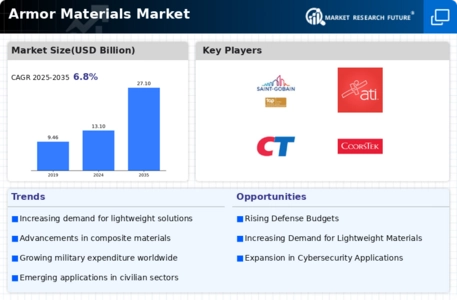Market Trends
Key Emerging Trends in the Armor Materials Market
The Armor Materials Market is undergoing transformation in response to changing security needs as well as technological advancements taking place in this field. One of such trends includes increased demand for lightweight high-performance armor materials by customers’ worldwide markets which they serve. Heavy traditional-like armors are being replaced by advanced ones which provide better protection without limiting mobility levels. This change is highly noticeable especially within defense and law enforcement, where agility of such systems really matters.
In addition there is a growing emphasis on composites development in Armor Materials Market. A combination between ceramics, metals and polymers often produces these composites enabling them accomplish both strength and flexibility targets simultaneously. The need for lighter materials with better ballistic capabilities has spurred innovations within the sector: a lot money is being spent on coming up with new types of armor materials that can withstand the effects of modern ballistic threats.
Another important trend is the rise of nanotechnology in the area of armor materials. At the molecular level, nanomaterials exhibit extraordinary strength and durability that provides them with an extra layer of protection. Nowadays, this technology is finding application both for civil and military use as it offers better performance against a broader spectrum of threats. For instance, there is development of nanocomposites to make more effective armors which can be used differently in different circumstances.
Transparent armor material demand also sky rockets in the Armor Materials Market. As a result of an increasing rate of insecurity, some products are required to offer ballistic protection but still be visible if need be. Transparent armors made from advanced glasses or polymer composites are now becoming vital elements used in vehicle and building protection. The concept behind these changes has been driven by the need for situational awareness even when people’s safety as well property should not be compromised.
The market is also witnessing a rise in the adoption of smart materials in armor applications. Smart materials, equipped with sensors and adaptive capabilities, can respond to changing conditions in real-time. This innovation allows for the creation of self-healing armor and materials that can adapt their properties based on the intensity of the threat. The integration of smart technologies is reshaping the landscape of armor materials, providing an added layer of sophistication to traditional protective solutions.

















Leave a Comment